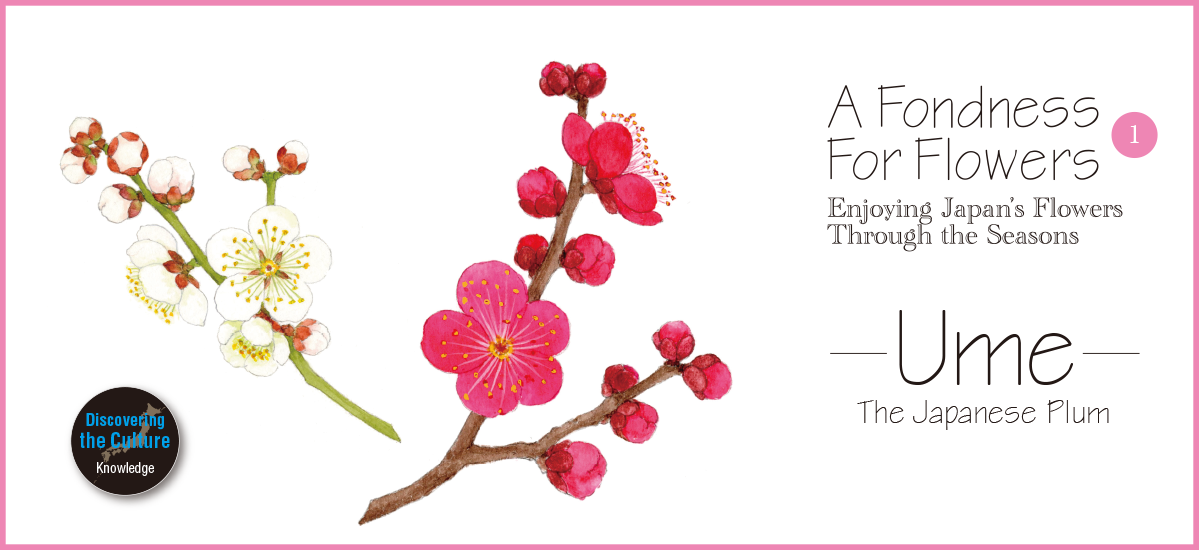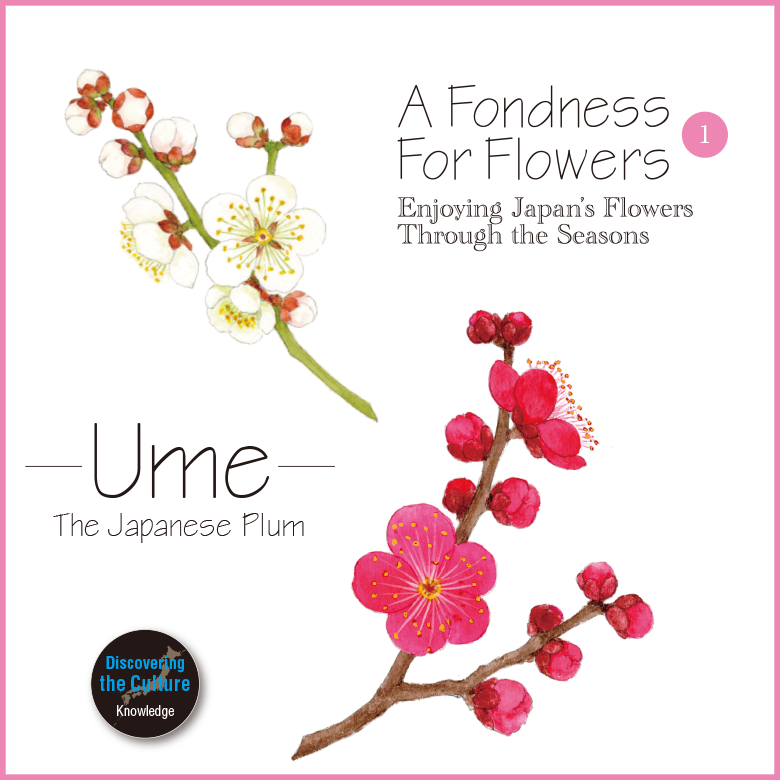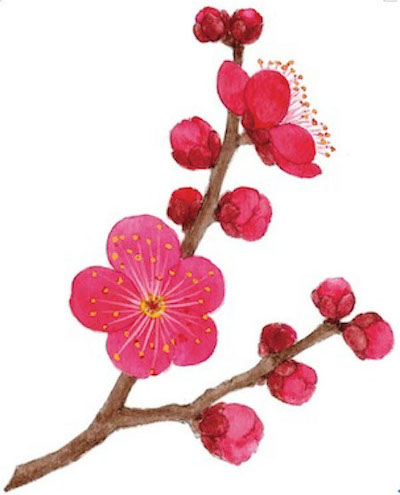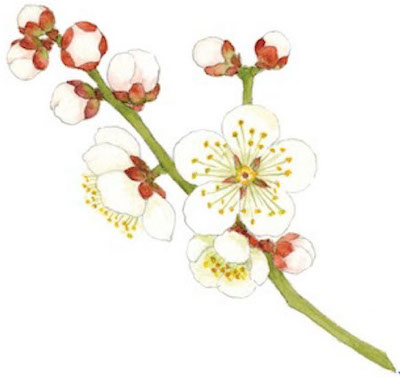

Flowering plants are intricately woven into the tales and legends of Japan, and feature prominently in Japanese art and poetry. Brimming with intelligence and ingenuity, the flowering plants all around us herald the coming of the seasons. Whether you live in Japan or are here as a visitor, take a moment to look about and see what the flowers have to tell you.
Illustration : Aso Yuriko / English Version : Judy Evans
Keyword : Nightingale / Japanese Birds / White-eye / Uguisu / Man’yōshū / Mejiro / Ume / Japanese Plum / Sakura / Cherry Blossom / Reiwa / Flying Plum
Ume (梅) – The Japanese Plum
Plant Family: Rosaceae.
Botanical name: Prunus mume.
Common Japanese names: ume; harutsuge-gusa; kōbunboku
Common English names: Japanese plum; flowering plum; Japanese apricot; Chinese plum
Place of origin: China
Prefectural tree: Ibaraki Prefecture; Ōsaka Prefecture; Wakayama Prefecture; Fukuoka Prefecture; Oita Prefecture.
Language of Flowers: nobility; devotion; perseverance; purity of mind.

The Elegant Flowering Plum – Deeply Rooted in Poetry and Tradition
In Japan, the names of the years correspond to the year of the current emperor’s reign, with a new era beginning with the reign of each new emperor. The abdication of Japan’s Heisei Emperor on April 30th, 2019, saw the end of the Heisei Era and the beginning of a new era, the Reiwa Era. “Reiwa”, a term that derives from Japan’s oldest anthology of poetry, the Man’yō-shū, has been interpreted to mean “beautiful harmony”.
The particular poem that the term Reiwa was taken from is a poem about the plum blossom. It is found in the preface attached to a group of thirty-two poems in the fifth volume of the anthology and reads, in classical Japanese, “Shoshun no reigetsu ni shite, kiyoku kaze yawaragi, ume wa kyōzen no ko o hiraki, ran wa haigo no kō o kaorasu”. The Prime Minister’s Office offers this English translation: “In this auspicious month of early spring, the weather is fine and the wind gentle. The plum blossoms open like powder before a mirror while the orchids give off the sweet scent of a sachet”. Reiwa is written with two Chinese characters from the poem, the character “rei”, taken from “auspicious month”, and the character “wa”, an alternative reading of “yawaragi”, meaning gentle or harmony.
Clearly, the Japanese plum, which blooms in January and February (coinciding with the month of the new emperor’s birthday), is closely connected to the name of the current era. And, as the poem in the 1300 year-old Man’yō-shū anthology shows, the plum is also an integral part of Japanese tradition. From time immemorial, the people of Japan have fondly anticipated the blossoming of the Japanese plum, which has long featured prominently in art and poetry. Of the approximately 4,500 poems in the Man’yō-shū, 1,500 mention plants – some 160 species in total. Of that number, 118 poems feature the plum tree, a number second only to the Japanese bush clover, which features in 140 poems.
Japan has long had a love of lists, a penchant that dates back many centuries before the term “listicle” was ever coined, and the Japanese plum pops up frequently in lists that refer to noble or elegant flowers. Accordingly, the plum is one of the “Three Friends of Winter” (Genkan no San’yū), a traditional art motif that includes pine, plum and bamboo, and one of the “Four Gentlemen” (Shi Kunshi), alongside bamboo, orchid and chrysanthemum. Then there are the “Four Friends of the Snow” (Setchū no Shiyū), a list of four plants that flower in the snow: plum, wintersweet, camellia and daffodil. The “San no Kimi” list of three auspicious flowers depicted in paintings that celebrate the coming of spring, consists of plum, daphne and daffodil. And the “Seven Fragrant Offerings” (Shichi Kōka), includes plum, lily, chrysanthemum, daffodil, gardenia, fragrant olive, and jasmine.
Tobiume – the Legend of the Flying Plum Tree
The Legend of the Flying Plum Tree dates back to when Sugawara no Michizane, a revered 9th century poet and scholar, lost favour with the court and was forced to leave his hometown of Kyōto for the remote region of Dazaifu in Kyūshū. As one did in those days, he bade farewell to his favourite plum tree with a poem. “Kochi fukaba, nioi okose yo, ume no hana, aruji nashi tote, haru o wasuru na.” (When east winds blow, spread your perfume, oh blossoms of the plum tree. Although your master has gone, do not forget the spring.) Michizane’s beloved plum tree stands in front of what is now the main hall of Kyōto Kitano Tenmangū Shrine, a major shrine dedicated to Michizane, which takes the plum blossom as its emblem.
The current tree is a deep pink-blossomed plum with its own name, Beni Wakon Bai, thought to be 350 years old. A quick bit of basic arithmetic suggests that a 350 year-old tree can’t possibly have been around when Michizane left for Dazaifu in the year 901, but apparently the present tree was grown by grafting part of the old tree onto new root stock. Meanwhile, the tree that Michizane composed his poem to is said to have pined for its master so much that it flew after him to Dazaifu, where it took root and grew, giving birth to the Tobiume (flying plum tree) legend. Dazaifu’s flying plum tree in can be found at Dazaifu Tenmangū Shrine near the city of Fukuoka, and is known as the “Irotama-gaki”. The shrine was built to commemorate Michizane, and the tree is over a thousand years old, which correlates to the date of Michizane’s removal to Dazaifu.
Every year these two plum trees put forth their blossoms. They spread their perfume just as Michizane wrote, and have never forgotten the spring. Curiously though, while the Beni Wakon Bai plum tree in Kyōto has deep pink blossoms, the blossoms of the Irotama-gaki tree in Dazaifu are white. It seems that the effort of flying all the way to Kyūshū caused it to lose its colour!

Why Plums Flower Earlier than Cherry Blossoms
Aside from Japan’s northern island of Hokkaidō, where plums and cherries tend to blossom at the same time, plum trees bloom earlier than cherries in Japan. This is reflected in how they are depicted in popular culture. Plum blossoms were selected in a nationwide vote in 1958 to feature as the January flower on the “Hana-goyomi” calendar, with cherry blossoms featuring as the April flower. In “Hana Awase”, a game played with traditional hanafuda playing cards, the plum blossom is the March suit and the cherry blossom the April suit.
Most people’s explanation of why plum trees flower earlier than cherry trees would be that plums flower at lower temperatures than cherries. While this isn’t exactly wrong, the simple explanation that plums flower at lower temperatures than cherries doesn’t take into account all the effort going on behind the scenes. The flower buds of both trees are formed during the previous summer, and spend almost a year preparing to bloom the following spring. Even if temperatures were particularly warm in January when the plum blossoms begin to open, the cherry trees would still not flower, so there’s more to this story than just the temperature at flowering time.
In autumn, when the nights get longer, the buds on plum and cherry trees become dormant, in a process known as over-wintering. Both species require a certain number of days of intense cold before the buds will break their dormancy, with cherries needing longer than plums. So, unlike the plum blossom buds, which are early risers, the deep-sleeping cherry blossom buds are still fast asleep in January and cannot be roused by an increase in temperature.
By January, when the buds of the cherry trees are still dormant, the flower buds of the plum have already had enough cold days to break their dormancy. Having already woken from their brief winter sleep, they bide their time until the temperatures warm slightly, when they begin to burst into flower. While it’s true that plum trees flower at lower temperatures than cherry trees, it’s not true to say that cherry trees will flower as soon as the temperature is right. Cherry blossom buds cannot break their dormancy until they have had a sufficient period of intense cold, and this required cold period is longer for cherries than it is for plums.
Is that a Nightingale in that Plum Tree?
There’s a tradition of thought in Japan, strongly influenced by classical paintings, that plum blossoms attract the Japanese nightingale (uguisu), also known as the Japanese bush warbler. Eye-witnesses will swear they’ve seen a “nightingale-coloured bird” among the plum blossoms. However, this is where things get complicated. The traditional colour known as uguisu-iro(nightingale colour) is a bright olive-green, but in reality, the nightingale is a drab brown colour. Now, while plum blossoms are indeed visited by a “nightingale-coloured” olive-green bird, this is not the nightingale but is, in fact, the warbling white-eye (Zosterops japonicus).
The nightingale, which inhabits dense thickets of brush where it feeds on insects and grubs, would not be attracted by the pretty blossoms of the plum tree. On the other hand, the white-eye, a nectar-feeding bird that also visits loquats and camellias, is an ardent fan of the plum blossom. Known as mejiro in Japanese, the white-eye is named for the ring of tiny white feathers around its eye. Next time you see “nightingale-coloured” wings flitting between the plum blossoms, take a closer look. That tiny bird with olive-green wings and a ring of white around each eye is no nightingale. What you’re seeing is the warbling white-eye, or mejiro.
The bright olive-green “nightingale colour” or uguisu-iro, has lent its name to traditional sweets such as uguisu-mame (sugared green peas) and uguisu-mochi (mochi coated in green soy bean flour). Perhaps these sweets should really be called “mejiro-mame” and “mejiro-mochi”, after the olive-green mejiro, not the drab brown uguisu. “Mejiro-iro” does have rather a nice ring to it!
This will never catch on though. In Japanese poetry and painting, nightingales are so deeply associated with plum blossoms that there’s no chance of replacing the nightingale with the white-eye. Nightingales and plum blossoms are both thought of as harbingers of spring, so there is a long tradition of depicting them together in paintings that has nothing to do with the feeding habits of the nightingale. Plums are the first of the spring-flowering plants to bloom, which gives them their other Japanese name, harutsuge-gusa (the flower that heralds spring). Likewise, the nightingale, whose song announces the coming of spring, bears the name harutsuge-dori (the bird that heralds spring), and it is this connection that brings the two together.
Text: Osamu Tanaka
Emeritus Professor at Kōnan University, Kōbe. Born in Kyōto, 1947. Studied in the Faculty of Agriculture, Kyōto University, where he earned his doctorate. Post-doctorate activities include a doctoral research fellowship at the Smithsonian Institution (United States), before becoming a lecturer in the Faculty of Science and Engineering at Kōnan University in Kōbe. A prolific author, Dr Tanaka has written many, many books, including Fushigi no Shokubutsugaku (The Wonders of Botany), Shokubutsu wa Sugoi (Plants are Amazing!), Shokubutsu no Himitsu (Plant Secrets), and Zassō no Hanashi (Speaking of Weeds), published by Chūōkōron-shinsha; Nyūmon Tanoshii Shokubutsugaku (Fun Introductory Botany) and Furūtsu Hitotsu-banashi (Tales of Fruit), pub. Kōdansha; Arigatai Shokubutsu (Plants to be Grateful for), pub. Gentōsha; Shokubutsu no Kashikoi Ikikata (Clever Plant Behaviour), pub. SB Shinsho; Shokubutsu no Ikiru Shikumi ni Matsuwaru 66-dai (66 Topics Related to Plant Life Systems), pub. Science Eye Shinsho; and Shokubutsu wa Oishii (Plants are Delicious), pub. Chikuma Shinsho.
Please note: The book title translations in parentheses are literal translations of the Japanese titles, provided for the benefit of our English-speaking readers. These translations are not actual published book titles.








